THE ETHIOPIAN EMPEROR HAILE SELASSIE (1930 - 1974),HE WAS A MEMBER OF SOLOMONIC DYNASTY.THE LAST EMPEROR IN THE 3000 - YEAR - OLD ETHIOPIAN MONARCHY,WHO RULED FOR HALF A CENTURY BEFORE HE WAS DEPOSED BY MILITARY COUP.
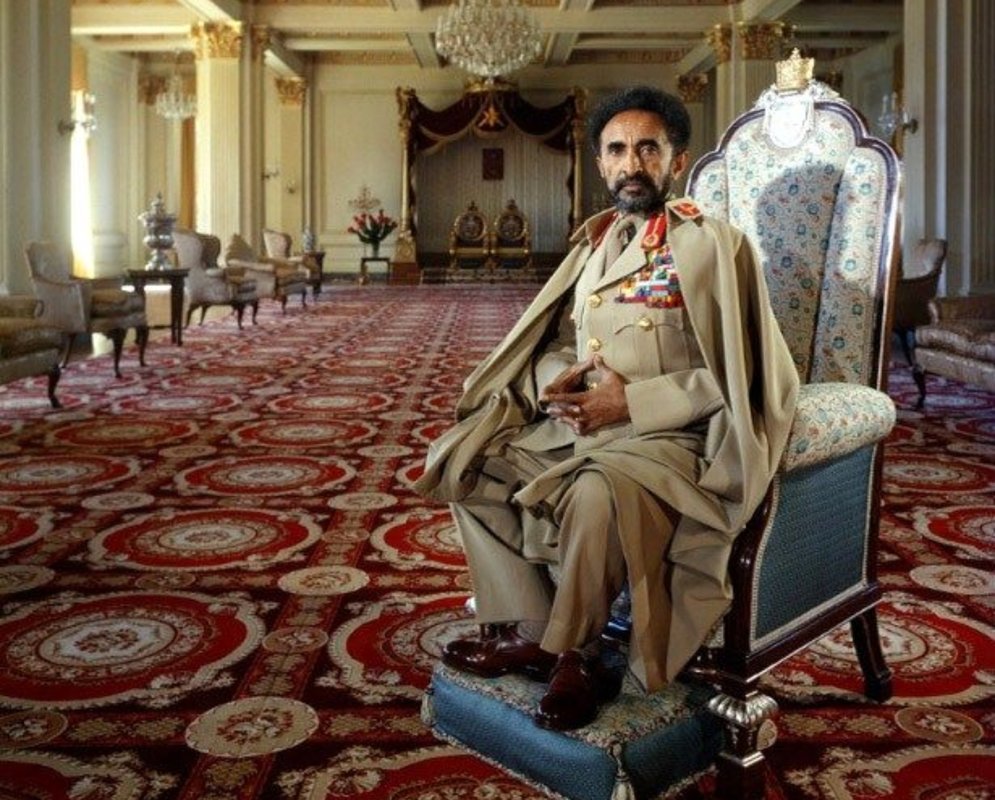 Haile Selassie I was Ethiopia’s 225th and last emperor, serving from 1930 until his overthrow by the Marxist dictator Mengistu Haile Mariam in 1974. The longtime ruler traced his line back to Menelik I, who was credited with being the child of King Solomon and the Queen of Sheba.
Haile Selassie I was Ethiopia’s 225th and last emperor, serving from 1930 until his overthrow by the Marxist dictator Mengistu Haile Mariam in 1974. The longtime ruler traced his line back to Menelik I, who was credited with being the child of King Solomon and the Queen of Sheba.
Haile Selassie was born near Harar, Ethiopia on July 23, 1892. His name at birth was Tafari Makonnen. Ras ("prince") Tafari displayed keen intellectual abilities early in his studies, and by the age of fourteen was appointed provincial governor. Upon his coronation as emperor of Ethiopia in 1930, he took the name Haile Selassie, which means "might of the trinity." He was also granted the title "Conquering Lion of the Tribe of Judah, Elect of God and King of the Kings of Ethiopia." Haile Selassie fled his country while in exile for a time during World War II. In 1941 he returned to power in Ethiopia. Early in his rule, he was considered a progressive reformer, who outlawed slavery and introduced educational, economic, and social reform s. He helped found the Organization of African Unity in 1963. However, as famine, economic depression, and the Eritrean crises worsened conditions in Ethiopia, he lost support. Selassie was deposed by military mutiny in 1974, and lived under house arrest until his death on August 26, 1975. In addition to having served as Emperor of Ethiopia from 1930 - 74, he is worshipped as a divine being by followers of the Afro - Caribbean Rastafarian religion .His mother was Yeshimbet Ali Abajiffar and his father was Ras (Duke) Makonnen Wolde Michael, Governor of Harrar, relative of Emperor Menelik II (1889-1913), and a former general who had played a key role in the 1896 Battle of Adowa where Ethiopia defeated an invading Italian Army to become the only African state to retain its independence by military action.His birth name given by his parents was Lij Tafari Makonnen. He was the only surviving son of the governor of Harar, Ras Makonnen Wolde Michael. Selassie traced his linage back to Menelik I, who was credited with being the child of King Solomon and the Queen of Sheba. He was raised a Christian and educated by private European tutors. His father passed on in 1906 and was taken under the wing of his uncle Menelik II who did not have a son to succeed him and SelassieI appeared to be the favoured successor.He spent his youth at the court of the emperor of Addis Ababa. He was exposed to political plots and learned about the use of power. The capacity of his memory, mastery of detail and hard work earned him the position of governor of Gara Muleta in the province of Harar at the age of fourteen. At the age of twenty Menelik II appointed him as commander of the extensive province of Sidamo.However his anticipated succession of Menelik II never took place as after the passing of Menelik II in 1913, his grandson Lij Yasu who was not a Tafari succeeded him. Yasu’s religion Islam cost him his leadership position as he maintained close ties with Islam in a Christian dominated country and he never gained favor with the Christian population. Selassie became the face of the opposition and later took power in 1916 and imprisoned Yasu for life. In 1917 Menelik II’s daughter Zauditu contested the throne and became empress and Selassie was named regent and heir to the throne.As the emperor he became a symbol of hopes and dreams of his country, trying to place his young country in the map. As leader his power increased, he led Ethiopia into the League of Nations in 1923 and by travelled to Europe, a first for an Ethiopian ruler in 1924. The empress showed less interest in politics but in religion, which was opposite to Selassie whose growing interest was in turning the country into a more modern one. He became stronger when he took control of the army in 1926, and this position allowed him to assume the title of king. In 1928 he became a self-proclaimed king and after the death of Zauditu in 1930 he demanded the title of King of Kings and took the name Haile Selassie (Might of the Trinity).The forty years of his power over the country and government led to him instituting a new constitution and centralizing his power. In 1935 his efforts were cut short when Benito Mussolini’s Italy invaded Ethiopia. He resisted the invaders with some of the feudal lords supporting him and others siding with the invaders. Selassie sent troops to Tigray in 1936, his army claimed a victory at the battle of Tembien, however the victory was short lived as the Italians overcame them by using mustard gas after the battle. The Ethiopian army retreated to Maychew and this was their final stand. Afterwards Ethiopia lost its national independence. The following year Selassie was forced into exile. The Ethiopians continue fighting the Italians by waging guerilla war. During the war he remained in exiled and banded his country together to fight the Italians. For aid he appealed to the League of Nations but was unsuccessful. He then went to British for help.
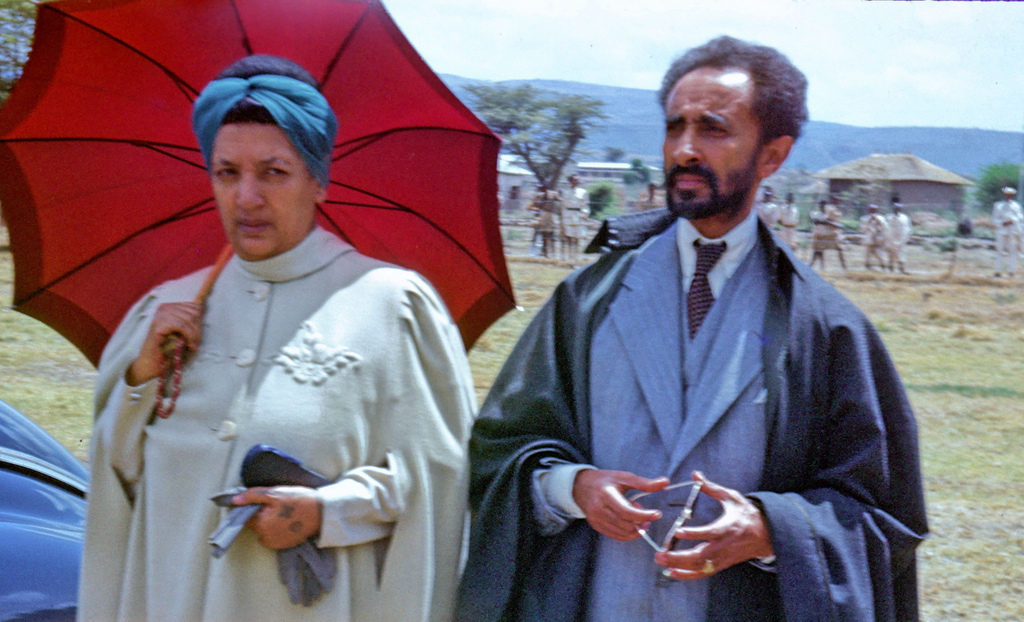 Haile Selassie (R) with his wife, Queen Menen.On the Emperor’s visit to Jamaica in 1966, The Guardian noted, a great crowd of Rastafarians surrounded the airport with banners showing the Ethiopian Lion of Judah.“Converging around the Ethiopian plane even as the propellers were turning, they sang praise to their god in human form, who they believed had come to redeem his Jamaican brethren,” it added.
Haile Selassie (R) with his wife, Queen Menen.On the Emperor’s visit to Jamaica in 1966, The Guardian noted, a great crowd of Rastafarians surrounded the airport with banners showing the Ethiopian Lion of Judah.“Converging around the Ethiopian plane even as the propellers were turning, they sang praise to their god in human form, who they believed had come to redeem his Jamaican brethren,” it added.
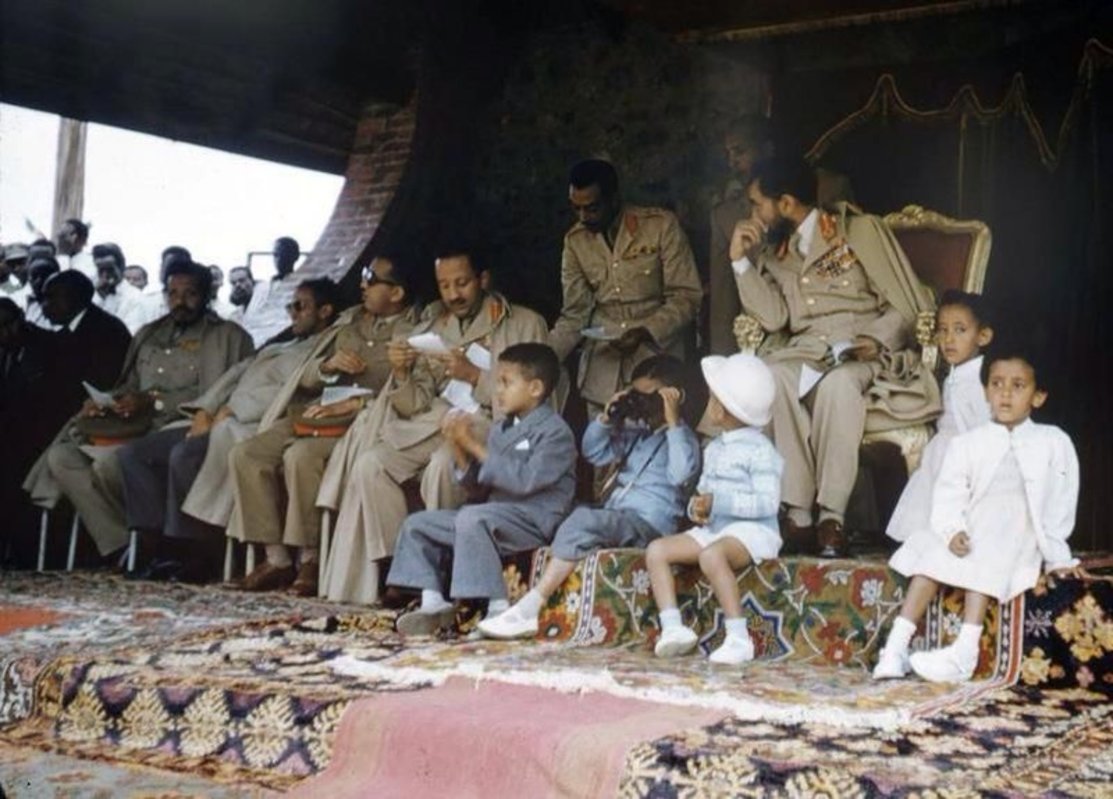 Addis Ababa, Ethiopia, Africa, 1954, Emperor Haile Selassie, the King of Abyssinia, and his family are pictured with L-R: Princesses Silvia (3), and Mary (4), daughters of the Crown Prince, Princes Michael (4), David (2) January 01, 1954.
Addis Ababa, Ethiopia, Africa, 1954, Emperor Haile Selassie, the King of Abyssinia, and his family are pictured with L-R: Princesses Silvia (3), and Mary (4), daughters of the Crown Prince, Princes Michael (4), David (2) January 01, 1954.
In 1941 the British finally came to his aid and freed the country from the Italian control. He returned to claim his throne. On his return to his country he found his administration destroyed. He dedicated himself to rebuild his administration and improving Ethiopia’s defense. Progressively many youngsters were sent to study abroad and learn what they could from other cultures. He improved the infrastructure of the country, and backed by the Western powers he managed to build bridges, hospitals, factories and schools. He was viewed as a reformer by many.Despite being a reformer he ruled with iron fist. He became paranoid about the partisans who had stayed behind and fought the Italians. He was intimidated by their bravery and decided to remove them from the position of authority and replaced them with those who collaborated with the enemy (Italians), because he knew that they could be kept easily in line and would be open to the methods of Selassie. His methods of maintaining power involved financial rewards and promotion of government officials. He gradually grew more cautious and allowed few new leaders into his new government. In 1962 he managed to absorb Eritrea into Ethopia.In Ethiopia all was not well. He suppressed political parties and opposition. Ethiopian peasants were starved while he was leaving a lavish lifestyle. Selassie was accused of breeding corruption and the creation of a system in which millions of his subject lived in poverty and oppression. People struggled to rebel with empty stomachs and this seemed to suit him. Media was censored and controlled by the emperor, and Western journalists were no longer allowed in the country. The suffering of his subject was finally exposed and caused great embarrassment to his reign. He exercised absolute control and punished those who questioned and undermined his authority, this led to attempt to a government coup in December 1960. The attempt failed and turned into a bloody massacre that sent a message to possible of plotters of what could happen to them.By the 1970s the situation in Ethiopia had worsened, with unemployment increasing, and government’s inability to respond to the country’s problems Selassie’s rule was undermined. He lost control over his army as many left the army over low pay. This weakened his defense and as the result he was ousted from power in a coup. He was kept under house arrest until his death in 1975.The cause of death was disputed; reports claimed he had died of natural cause but another one revealed that he had probably been strangled to death on governmental orders. His remains were discovered in 1992. He received a proper burial in November 2000 in Addis Ababa’s Trinity Cathedral. Appointed governor of Harrar Province, Tafari Makonnen, despite his descent from previous Emperors, would likely have remained an unimportant political figure had he not married his second wife, Menen Asfaw, niece to the heir of the Ethiopian throne, Lij Iyasu. When rumors spread that Iyasu was flirting with Islam, Ethiopian nobles made Tafari regent in 1916. Elevated to the rank of Ras, Tafari began to rule in fact while Empress Zewditu, the daughter of Emperor Menelik II, was official head of state. As regent Ras Tafari Makonnen began the transformation of Ethiopia. He ended slavery in 1923 and established a school for newly freed slaves in the capital, Addis Ababa. By ending slavery Selassie secured Ethiopia’s admission to The League of Nations. Selassie also began touring Europe both to acquire knowledge and assistance in his modernization efforts and to raise the profile of the only independent monarchy on the African continent.Ras Tafari Makonnen became Emperor outright in 1930 upon the death of Empress Zewditu. Upon assuming the throne, he took the name Haile Selassie meaning “Might of the Trinity.” Continuing his modernization of the state, Selassie in 1931 established the first Ethiopian constitution which centralized governmental power under his leadership. Selassie believed that a more powerful central government was necessary to carry out his modernization ideas for the nation’s bureaucracy, military, and economy. Selassie also focused his attention on increasing public health services, providing electricity, and creating a modern telephone network. In 1931 he founded the Bank of Ethiopia which introduced Ethiopian currency.Selassie’s ambitious programs were threatened by the imperial designs of Italian leader Benito Mussolini. Italy had already held Eritrea just north of Ethiopia and was looking to avenge its defeat at the Battle of Adowa in 1896.Without warning Italy invaded Ethiopia on October 3, 1935 and fought for seven months. Although the League of Nations named Italy the aggressor in the conflict, no further actions were taken. Italian forces easily defeated the Ethiopian Army forcing Halie Selassie and his family into exile in Great Britain on May 2, 1936. Soon afterwards, on June 30, 1936, he gave his most famous speech before the League of Nations, where he protested the use of chemical weapons against his people and decried the advent of the technological “refinement of barbarism.” Despite widespread praise of his speech and sympathy for the Ethiopian people, Western powers did not come to his assistance in the campaign against the Italians.Although the League failed to act, by 1939, Great Britain and France, now at war with Germany and Italy, came to Ethiopia’s aid. On May 5, 1941 Selassie re-entered Ethiopia with the assistance of South African, British, and Ethiopian soldiers. By January 1942 all Italian troops had been driven from the country. Haile Selassie accepted British military assistance. He did not, however, accept their political help in rebuilding Ethiopia, believing they intended to undermine his authority. Selassie become increasingly concerned about outside influences in his nation and slowed the modernization process he had initiated upon becoming Emperor. Ethiopia increasingly became an autocratic state isolated from much of the rest of the world community. Selassie devoted resources to controlling Eritrea which came under Ethiopian rule after World War II. His military rule of that region led to an independence campaign that triumphed finally on May 24, 1993. Despite his country’s poverty and political stagnation, Selassie viewed himself as a world leader. Ethiopia became a charter member of the United Nations in 1945. In 1950 he sent Ethiopian troops to fight under Allied command in Korea. Throughout the rest of the decade he traveled widely. In 1954, for example, he became the first head of state to visit newly independent West Germany. Nine years later, in 1963, he helped found the Organization of Africa Unity and built its headquarters in Addis Ababa. After visiting Jamaica in 1960, the Rastafarians, with thousands of supporters world wide, proclaimed him a living God. Selassie, however, seemed unable to control the growing political dissatisfaction over his reign which became even more pronounced by a series of crop failures and famines between 1972 and 1974 which killed 80,000 people and brought millions of Ethiopians to the brink of starvation. Two years later in 1974, after riots and hyperinflation paralyzed his government, the Derg, a committee of Army officers, deposed the Emperor and announced the end of the empire.
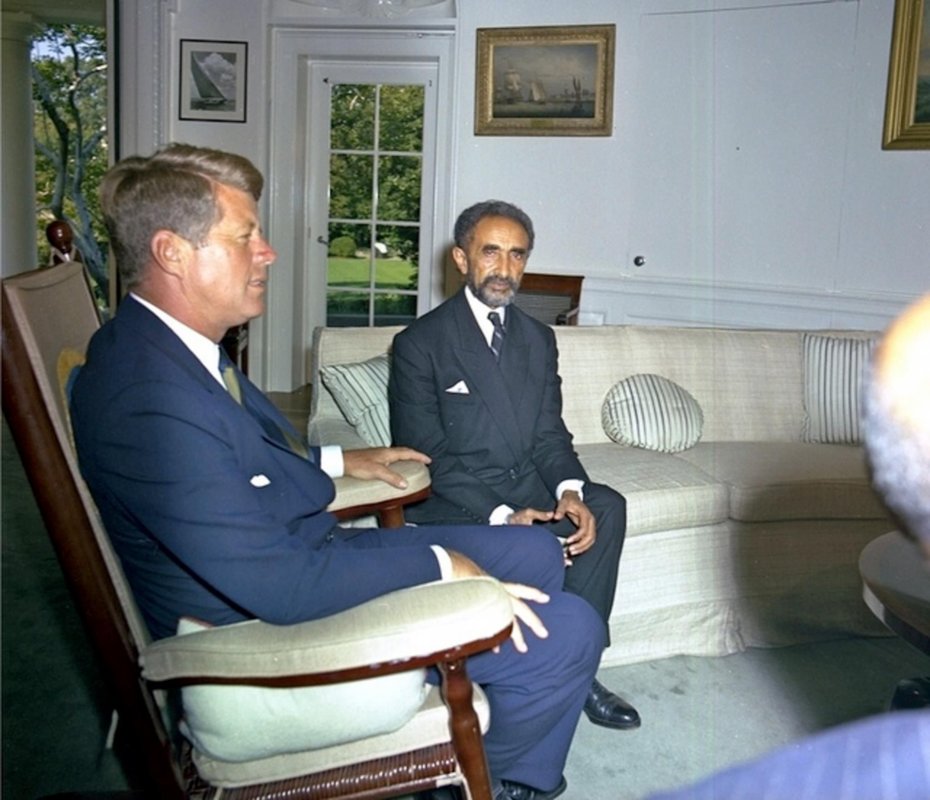
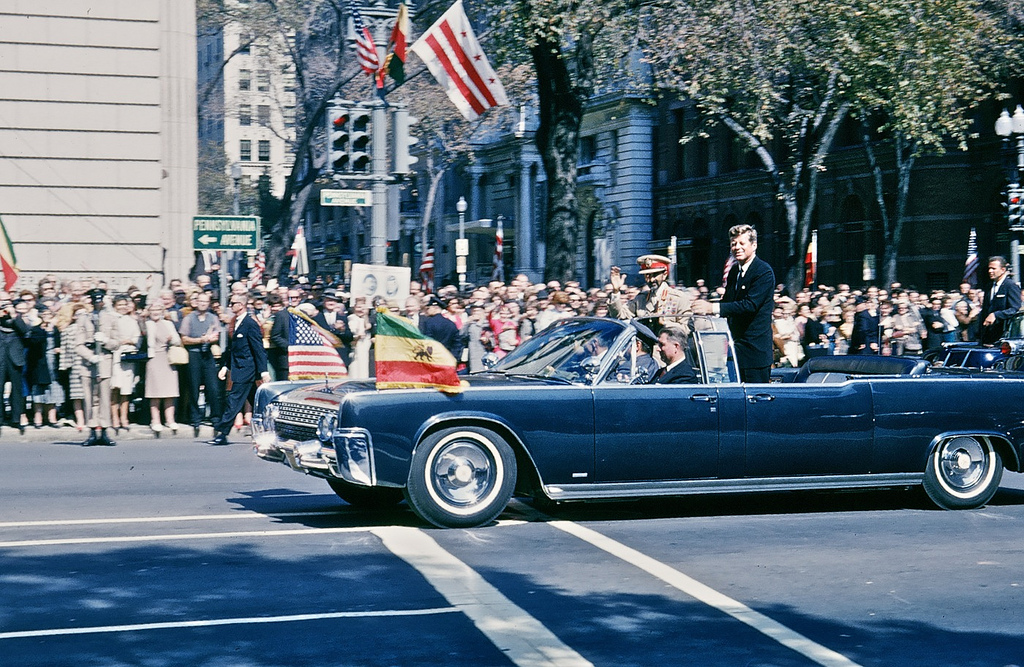 Haile Selassie with U.S. President Kennedy .Haile Selassie is giving JFK Jr, a gift, which is a statue carved out of ivory.President John F. Kennedy with Emperor of Ethiopia, Haile Selassie I, following a farewell meeting. Also pictured: Imru Haile Selassie, second cousin of Emperor Selassie; Minister of the Imperial Court of Ethiopia.
Haile Selassie with U.S. President Kennedy .Haile Selassie is giving JFK Jr, a gift, which is a statue carved out of ivory.President John F. Kennedy with Emperor of Ethiopia, Haile Selassie I, following a farewell meeting. Also pictured: Imru Haile Selassie, second cousin of Emperor Selassie; Minister of the Imperial Court of Ethiopia.

